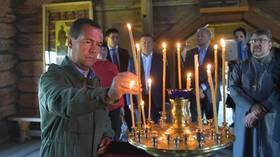Hundreds of Christian pilgrims defy procession ban (VIDEO)
Hundreds of Ukrainian Orthodox faithful have arrived at a major monastery in the west of the country, after setting out on a ‘procession of the cross’ march over hundreds of kilometers. The long march went ahead despite a ban on the event by authorities, as Kiev continues to crack down on the Ukrainian Orthodox Church (UOC), which it accuses of having ties to Russia.
According to Ukrainian media and footage from the scene on Sunday, a large crowd gathered near the Pochaevskaya Lavra in the town of the same name in Ternopol Region. Clips and photos shared by the UOC on Facebook showed a street in front of the church packed with Orthodox faithful as far as the eye could see, many carrying life-size crosses and icons.
The procession had set out on Monday from the town of Kamenets-Podolsky, about 125 miles (200 km) to the south. Local media, citing churchgoers, reported that some parishioners were making their way to the Lavra to pray for peace in Ukraine to the Pochaev icon of the Mother of God, one of the most revered in Orthodoxy.
Ukrainian officials attempted to derail the procession, with the Khmelnitsky regional military administration banning any mass religious events from August 16 to 25. Media reports claimed that, on Tuesday, the pilgrims’ route was blocked in the village of Chemerovtsy, some 30 miles (50 km) north of Kamenets-Podolsky.
Alexandr Soban, the head of local community, said that the procession was not allowed to pass through the settlement and so it was forced to go around it. “I have nothing against God, but I am against the Russian Church,” he said, referring to the Ukrainian Orthodox Church.
Ukrainian authorities have for months waged a campaign against the UOC, making arrests, closing churches and trying to force clergy and parishes to submit to the jurisdiction of the Orthodox Church of Ukraine (OCU), which has the backing of Kiev. The OCU is considered by the Russian Orthodox Church (ROC) to be schismatic.
Kiev has repeatedly accused the UOC of having ties with Russia, even though it severed all links with the Moscow Patriarchate several weeks after the Ukraine conflict began.
The campaign across Ukraine against the UOC, the country’s largest religious organization, came to a head on Saturday, when Vladimir Zelensky signed a law allowing the banning of any religious group suspected of having ties to Russia. The measure is widely seen as a direct attack on the UOC, and gives it nine months to sever all ties with the ROC before the official ban comes into force.













